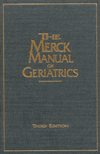Reviewed by: Barry Goldlist
 The Merck Manual of Geriatrics, 3rd Edition
The Merck Manual of Geriatrics, 3rd Edition
Published by Merck Research Laboratories
Whitehouse Station, NJ 2000
Almost a decade ago, I received a copy of the first edition of the Merck Manual of Geriatrics for review, and decided to take it on ward rounds with my residents. Rather than my answering their patient related questions, we looked things up in the manual and were all favourably impressed by the results. It was easy to use, and provided rapid access to succinct and helpful information. Needless to say, my review of the volume was very favourable. I was still able to give my residents good evaluations because they said they still preferred my answers. Smart residents.
The third edition of the manual is much larger, and significantly heavier than was that original volume. It has gone from 1267 pages in length to 1507 pages, and the pages are larger. It would not accompany anybody on ward rounds. However, with the added weight comes more information. It is still very easy to extract information in order to answer specific clinical questions because of the excellent index, and the usual Merck technique of making the chapter headings visible via 'thumb holes'. Not only does it provide excellent information on specific geriatric issues such as falls, incontinence, and interdisciplinary teams, it also provides good coverage of important issues in general internal medicine that relate to the elderly.
Unlike standard textbooks of geriatric medicine, the geriatric giants (incontinence, falls, etc.) are not grouped together, but rather are addressed in the appropriate system section. However, this method of indexing does not cause any problems. As in previous editions, many charts are used to transmit information in a very efficient manner.
Who should buy this textbook? It is not intended to be a comprehensive textbook of geriatrics, and the lack of references probably makes it inappropriate for purchase by those who specialize in geriatrics. However, the ease of use, and the wide variety of useful information it contains, would make it a useful text for family physicians or internists who treat elderly patients in their practices. It would also be a useful textbook for trainees in those disciplines. I highly recommend it.

 The Merck Manual of Geriatrics, 3rd Edition
The Merck Manual of Geriatrics, 3rd Edition